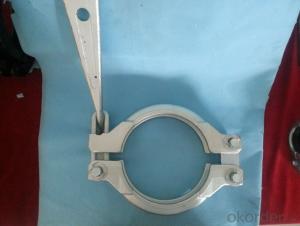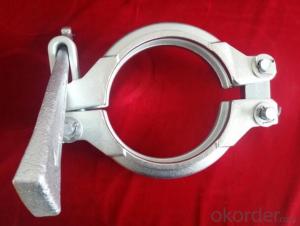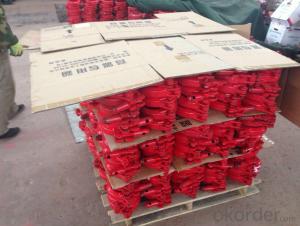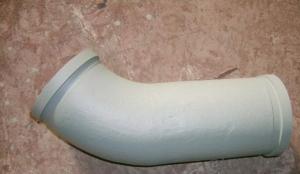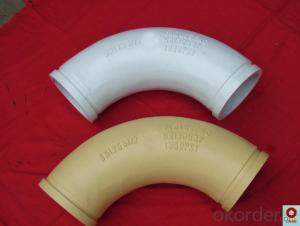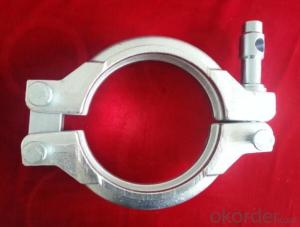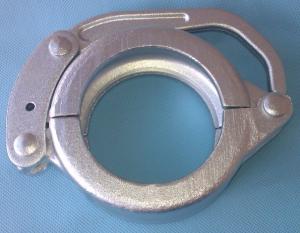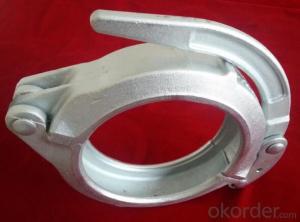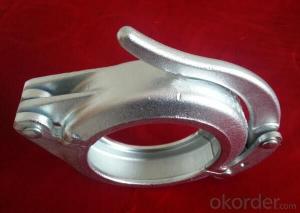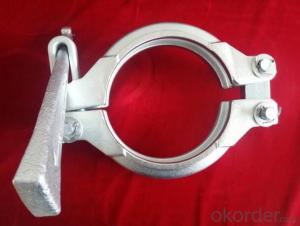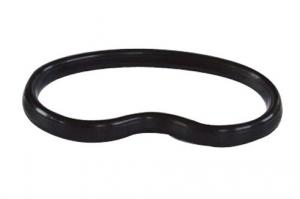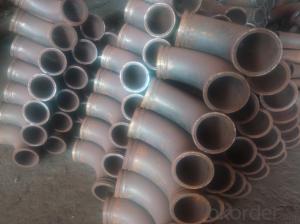Concrete Pump Clamp Coupling Forged zx150 6
- Loading Port:
- China main port
- Payment Terms:
- TT OR LC
- Min Order Qty:
- 50 PCS
- Supply Capability:
- 10000 PCS/month
OKorder Service Pledge
OKorder Financial Service
You Might Also Like
Product Description:
A coupling is a device used to connect two delivery pieps together at their ends for the purpose of transmitting, and prevent the concrete from leaking. Couplings do not normally allow disconnection of shafts during operation.
Main Product Features:
1. Use high quality steel. After high-temperature 1200 forging,it’s shaped.
2.High temperature forging.
3.convenient to use, easy operation,and high safety.
4.good sealing,wear-resising,longer service life.
5.do not restrict the steering tubes, pipes during the working process can be 360 degrees rotation.
6.used in concrete pump truck,concrete pump and pipeline connection seal in construction
work equipment.
Product Specifications:
1.Forged
2.2--8 inch
3.Galvanizing/Baking varnish
4.More durable,light,beautiful
Production steps:
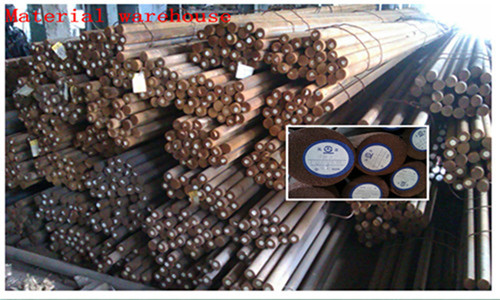

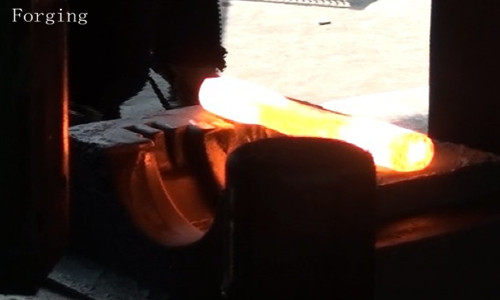
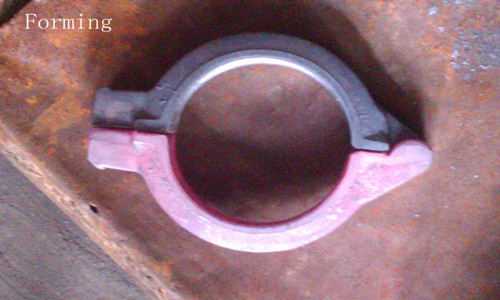

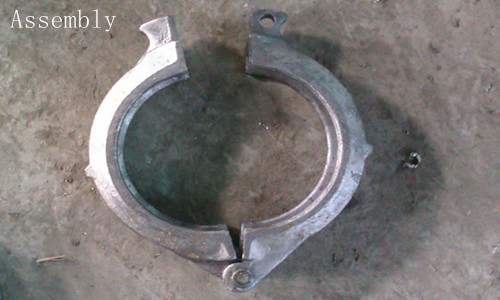
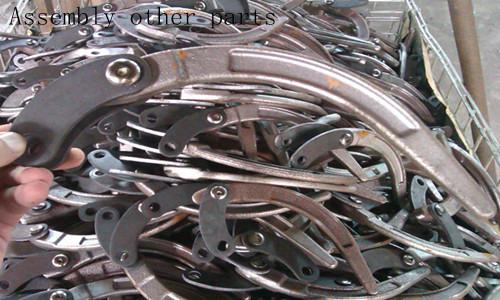
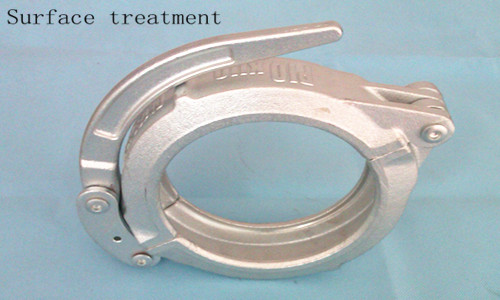
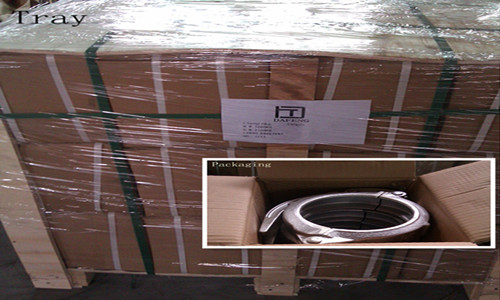
Concrete pump clamp Catalogue
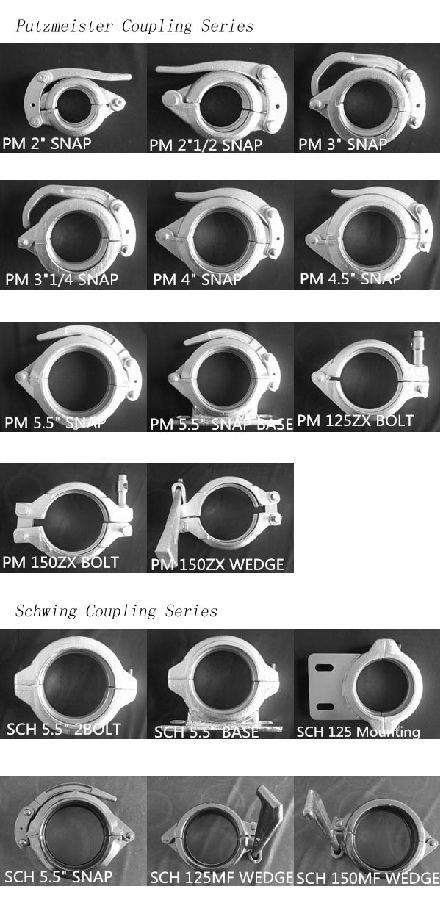
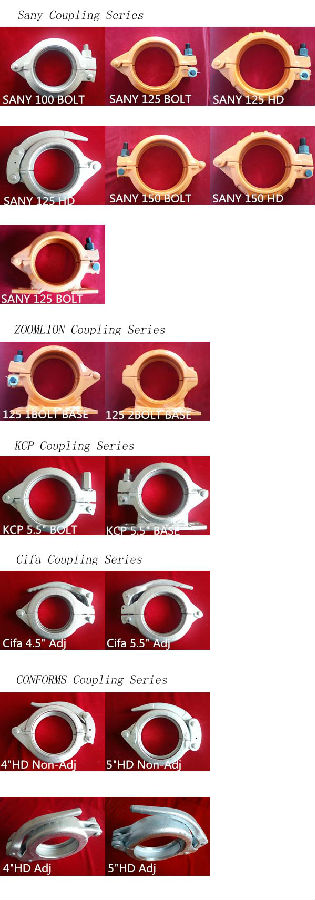
FAQ
1.How do you regarding your product quality?
As our principle is more safety to save more. In China, there are lots of manufactures of this line, but we are the first one that use the forging technic in producing, firmly meet the PM standard.
2.Can I get some samples?
Of course you can. Small sample for free, but you pay the express. For some products are not small, like concrete pump pipe, it’s very difficult to deliver one pipe of 3000mm. If it’s possible, we’d like that you can come here to visit our factory. Welcome!
3. I want to make our logo on the products, is that ok?
Yes, it’s totally ok. OME is available from us.What you should do is send your logo, brand name, or picture to us. And let other things leave on us.
- Q: How often should concrete pump control panels be inspected and replaced?
- Concrete pump control panels should be inspected regularly to ensure they are functioning properly and to identify any potential issues or malfunctions. The frequency of inspections may vary depending on several factors such as the type of pump, the operating conditions, and the manufacturer's recommendations. However, a general guideline is to have a thorough inspection at least once every six months or after every 500 hours of operation, whichever comes first. During these inspections, trained professionals should check for any signs of wear or damage on the control panel components, including buttons, switches, indicators, and wiring. They should also verify the functionality of the control panel by testing all the different functions and safety features. In terms of replacement, it is essential to follow the manufacturer's guidelines and recommendations. Typically, control panels have a lifespan of several years, but this will depend on various factors such as the quality of the panel, frequency of use, and maintenance practices. If any significant issues or failures are identified during inspections, it is important to replace the control panel promptly to ensure the safe and efficient operation of the concrete pump. Ultimately, regular inspections and prompt replacement of control panels are crucial to minimize the risk of equipment failure, ensure safety on the construction site, and maintain the productivity and longevity of the concrete pump.
- Q: Can I get spare parts for both concrete pumps with and without emergency stop systems?
- Yes, you can get spare parts for both concrete pumps with and without emergency stop systems. Most manufacturers and suppliers of concrete pumps offer a wide range of spare parts that are compatible with various models and types of pumps. These spare parts include components like hoses, pipes, valves, seals, and other essential parts that may need replacement due to wear and tear or damage. Whether your concrete pump has an emergency stop system or not, you should be able to find the necessary spare parts to keep your pump running smoothly. However, it is important to note that the availability of specific spare parts may vary depending on the brand, model, and age of your concrete pump. To ensure you get the right spare parts, it is advisable to consult the manufacturer or supplier of your concrete pump. They can provide you with a comprehensive list of spare parts and guide you in selecting the appropriate ones for your specific pump. Additionally, they may also be able to assist you with any technical support or troubleshooting related to your concrete pump.
- Q: How can a faulty hydraulic filter affect the pump's hydraulic system?
- A faulty hydraulic filter can negatively impact the pump's hydraulic system in several ways. Firstly, it can allow contaminants such as dirt, debris, or particles to enter the hydraulic fluid, causing damage to the pump and other components. These contaminants can also clog or block the filter, reducing its efficiency and restricting the flow of fluid. This can lead to increased pressure, decreased performance, and potential overheating of the hydraulic system. Additionally, a faulty filter may fail to remove water or other contaminants from the fluid, further compromising the system's performance and reliability. Overall, a faulty hydraulic filter can result in reduced efficiency, increased wear and tear, and ultimately, system failure if not addressed promptly.
- Q: How often should concrete pump accumulators be inspected and replaced?
- Concrete pump accumulators should be inspected at least once a year to ensure their proper functioning and identify any potential issues. However, the frequency of replacement depends on various factors such as usage, maintenance, and the manufacturer's recommendations. It is recommended to consult the equipment manual or contact the manufacturer for specific guidelines on replacement intervals.
- Q: What is the role of a concrete pump hopper agitator blade?
- The role of a concrete pump hopper agitator blade is to mix and agitate the concrete mixture in the hopper, ensuring a consistent and homogeneous mixture. This helps to prevent the concrete from settling or becoming too thick, allowing for a smoother and more efficient pumping process.
- Q: What are the indications of a damaged concrete pump boom?
- There are multiple signs that can indicate a damaged concrete pump boom. These signs encompass: 1. Physical damage that is visible: One of the most apparent indications of a damaged concrete pump boom is the presence of visible physical damage. This can manifest as cracks, dents, or deformities in the structure of the boom. It is crucial to take any signs of structural damage seriously as they have the potential to compromise the integrity of the boom. 2. Leaks: Another sign of a damaged boom is the occurrence of leaks. If you observe hydraulic fluid or water leaking from the boom, it could be an indication of damage to the hose or fitting. Leaks not only impact the pump's performance but also pose a safety hazard to the operator and those in the vicinity of the equipment. 3. Misalignment: A damaged boom might also display issues with misalignment. If the boom is not straight or appears to be bent at an unusual angle, it could signify damage. Misalignment can negatively affect the accuracy and efficiency of concrete placement, which could result in uneven or improper pouring. 4. Unusual noises: Unusual or excessive noises during operation can be a sign of a damaged boom. Sounds such as rattling, grinding, or squealing may indicate loose or worn-out components like pins, bushings, or bearings. It is important not to ignore these noises as they could worsen if not promptly addressed. 5. Decreased performance: A damaged boom can also lead to reduced performance. If you notice a decrease in pumping capacity or encounter difficulties in controlling the movement of the boom, it could signify damage. Poor performance can stem from various issues, including problems with the hydraulic system, structural damage, or worn-out parts. To conclude, regular inspections and maintenance of concrete pump booms are vital in order to identify any signs of damage. Addressing these issues promptly is essential to ensure the safety of operators, prevent further damage, and uphold the efficiency and performance of the equipment.
- Q: How do concrete pump spare parts help in the pumping process?
- The smooth and efficient operation of a concrete pump relies heavily on spare parts. These parts are crucial for enhancing performance, extending the pump's lifespan, and ultimately saving costs. The use of concrete pump spare parts offers several advantages, one of which is improved pumping efficiency. These parts are meticulously manufactured to ensure the optimal flow of concrete through the pump. For example, the wear plate, wear ring, and S valve all play a crucial role in reducing friction and enhancing pumping performance. By minimizing friction and maintaining a consistent flow, these spare parts prevent blockages and allow for the smooth and efficient pumping of concrete. In addition, concrete pump spare parts are vital for minimizing downtime and reducing maintenance costs. Since the pump operates continuously, wear and tear are inevitable. However, replacing worn-out parts with high-quality spare parts on a regular basis can significantly prolong the pump's lifespan and decrease the need for frequent repairs. Investing in durable and reliable spare parts helps operators avoid unexpected breakdowns and costly repairs, ensuring uninterrupted and efficient pumping operations. Furthermore, concrete pump spare parts contribute to the safety of the pumping process. Components such as the safety valve, hopper grate, and control system all play critical roles in preventing accidents and ensuring the well-being of operators. These spare parts are designed to facilitate the safe and controlled pumping of concrete, reducing the risk of equipment failure and potential hazards. In conclusion, concrete pump spare parts are indispensable in the pumping process as they improve efficiency, minimize downtime and maintenance costs, and enhance safety. By investing in high-quality spare parts, operators can optimize the pump's performance, increase productivity, and achieve long-term cost savings.
- Q: How can a faulty concrete pump cylinder affect the pumping process?
- A faulty concrete pump cylinder can have a significant impact on the pumping process. The cylinder plays a crucial role in the concrete pumping system as it is responsible for generating the necessary pressure to push the concrete through the pipes and hoses. One of the main issues caused by a faulty cylinder is a decrease in pumping efficiency. If the cylinder is worn out or damaged, it may not be able to generate sufficient pressure to push the concrete effectively. This can lead to a decrease in the pumping rate and overall productivity of the concrete pumping operation. Furthermore, a faulty cylinder can result in irregular and inconsistent flow of concrete. This can cause blockages or clogs in the pipes, leading to disruptions in the pumping process. These blockages can be time-consuming and costly to remove, as they may require the disassembly of the pumping system to access and clear the blocked area. In addition, a faulty cylinder can cause leaks in the pumping system. These leaks not only waste concrete but also reduce the overall pressure in the system, affecting the ability to pump the concrete to the desired location. Leaks can also lead to a messy worksite, posing safety risks for workers and potentially damaging surrounding structures. Moreover, a faulty cylinder can increase the risk of equipment failure. If the cylinder malfunctions or fails completely, it can cause the entire pumping system to shut down. This can result in significant downtime and delays in the concrete pouring process, leading to additional costs and potential penalties. Overall, a faulty concrete pump cylinder can greatly affect the pumping process by decreasing pumping efficiency, causing irregular flow, promoting leaks, and increasing the risk of equipment failure. Regular maintenance, inspection, and timely replacement of the cylinder are essential to ensure smooth and efficient concrete pumping operations.
- Q: Are there any specific quality control measures for the production of concrete pump spare parts?
- Yes, there are specific quality control measures for the production of concrete pump spare parts. These measures include rigorous inspection and testing processes at various stages of production to ensure that the spare parts meet the required specifications and standards. The quality control measures may involve dimensional checks, material testing, performance evaluation, and adherence to industry regulations. Additionally, manufacturers may implement quality management systems, such as ISO 9001, to maintain consistent quality and continuous improvement in the production of concrete pump spare parts.
- Q: What are the key considerations when purchasing spare parts for a concrete pump?
- When buying spare parts for a concrete pump, there are several important factors to think about. These factors include making sure that the spare parts are compatible with the concrete pump's make and model, checking their quality and reliability, ensuring their availability, and considering their cost-effectiveness. First and foremost, it is crucial to make sure that the spare parts you purchase are suitable for the concrete pump you have. Concrete pumps come in different makes and models, and each may have specific requirements for spare parts. Therefore, it is essential to carefully match the specifications and requirements of the concrete pump with the spare parts you buy to ensure proper functionality and performance. The quality and reliability of the spare parts are also important considerations. Investing in high-quality spare parts can have a significant impact on the efficiency and lifespan of the concrete pump. It is advisable to choose spare parts from reputable manufacturers or suppliers who have a proven track record of producing reliable products. Doing thorough research and reading customer reviews can help assess the quality and reliability of the spare parts. Availability is another crucial factor to consider when purchasing spare parts for a concrete pump. It is important to ensure that the spare parts you need are easily accessible, either from local suppliers or through efficient delivery channels. Delays in obtaining the necessary spare parts can result in extended downtime and increased costs. Therefore, it is recommended to choose suppliers with a reliable and efficient distribution network. Cost-effectiveness is also a key consideration when buying spare parts. While it is important to prioritize quality and reliability, it is equally important to find spare parts that offer good value for money. Comparing prices from different suppliers and considering the lifespan and potential maintenance costs of the spare parts can help make a cost-effective decision. It is crucial to strike a balance between cost and quality to ensure the best return on investment. In conclusion, when purchasing spare parts for a concrete pump, it is important to consider compatibility, quality, availability, and cost-effectiveness. By carefully evaluating these key factors, you can ensure that the spare parts you choose will meet the specific needs of your concrete pump, maintain its performance and reliability, and provide value for your money.
Send your message to us
Concrete Pump Clamp Coupling Forged zx150 6
- Loading Port:
- China main port
- Payment Terms:
- TT OR LC
- Min Order Qty:
- 50 PCS
- Supply Capability:
- 10000 PCS/month
OKorder Service Pledge
OKorder Financial Service
Similar products
Hot products
Hot Searches
Related keywords
